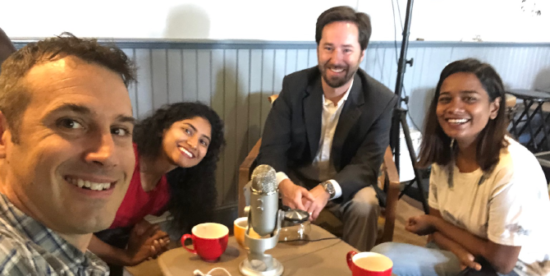By Tim Horgan, Executive Director, World Affairs Council of New Hampshire

Tim Horgan (second from right) records a podcast with two exchange participants following their time on the International Visitor Leadership Program.
Creating new avenues for your organization to engage with potential members and resources can be daunting. Building outreach materials, crafting a prospect list, and reaching out through mailers can be exhausting, time consuming, and frustrating. Materials can get stale quickly, requiring more expenditures, updates, and outreach.
One tool that may help you better reach your community and engage new people in an exciting way are podcasts. At the World Affairs Council of New Hampshire, we launched our podcast “Global in the Granite State” earlier this year. Here are some reasons why you should consider starting a podcast:
WHY PODCASTS?
In today’s busy world, podcasts are a great way to engage with your audience without taking up additional time. You can listen to a podcast in your car, on the beach, or while cleaning your house. It can also help you engage with a new audience who might be interested in your organization, but may not have the time to come to events. Finally, it can be a great way to pull in donors, sponsors, and prospects to your organization—simply ask them for 15-20 minutes to be interviewed and use that to start cultivating contacts.
MYTH #1: PODCASTS ARE EXPENSIVE AND TECHNICAL.
Yes, equipment and software can be expensive if you are planning to use top-of-the-line products. However, you can still create an entire podcast with just your phone and a computer. There are many voice recording apps that are free to download to your phone.
You can also purchase professional microphones for less than $100, which provide higher sound quality and more options (I use the Blue Yeti USB Microphone). Hook it into your laptop, find a quiet space, and you’ve got a mobile recording studio. Test the settings on the microphone to get the sound you want.
When it comes to editing and adding music to your recordings, you can also do it for free. Audacity provides a wonderful, open source (read: free), audio editing program that is super easy to use—it’s almost scary how easy it is. Simply highlight the parts of the audio you want to remove, hit the delete button, and it’s gone.
Want to re-order your interview questions? Highlight, cut, and paste. Adding music is also simple—just make sure to steer clear of copyrighted materials. There are many websites that have uncopyrighted music for you to use.
MYTH #2: PODCASTS TAKE A LOT OF TIME.
The amount of time you spend depends on how often you are looking to publish episodes and the type of program you put together. It can certainly be a full-time job to release new podcasts if you are setting up several interviews per episode.
I have found that one podcast per month that includes two 10-15 minute interviews is easily achievable. Deciding who to interview and what to talk about can be the most difficult part. Overall, I spend about five hours total to record and produce an episode. Even with a staff of two full-time people, doing 25+ events, and 40+ IVLP visits a year, podcasts are still a reasonable time investment.
MYTH #3: I WOULDN’T KNOW WHAT TO TALK ABOUT ON THE PODCASTS.
A theme is helpful to guide your thinking, but don’t get too bogged down in one subject. For the World Affairs Council of New Hampshire, the “Global in the Granite State” podcast focuses on all things global in the state (pretty simple). This allows me to talk with international visitors about their time in the state, or to talk with international organizations based in New Hampshire that are doing great work abroad. I also interview experts about important international issues.
You can take a unique view on any topic that fits into your organizational marketing and outreach goals. Want to engage more young people in your work? Interview young professionals. Want people to engage more in learning about international affairs? Talk with local professors who have expertise in a particular area. Wish you had more students participating in a program? Get previous participants to talk about their experiences and why others should get involved.
MYTH #4: IT’S HARD TO ADVERTISE PODCASTS AND GET LISTENERS.
This is where some investment may be required. You can post the audio files to your website and link to them in emails, social media, and other digital outreach. However, posting on podcast hosting sites can extend your reach further.
Some sites, like SoundCloud, allow you to post a few episodes for free before upgrading to a paid account. This is a good way to test it out and get some basic analytics on your listenership. Paid accounts provide additional tools to help you build your audience, which may be of interest, but carefully consider what you want out of your podcast.
Once the recordings are posted online, promote the heck out of it. Send the link to your interview subjects and tell them to share it with their networks. Blast it out to your contacts and be sure to explain what it is and what it is not (when I tell people that it is like listening to NPR online, they seem to better understand it). It can be a slow process, but nothing ever worth doing is easy.
While you may think this is something only larger organizations with much bigger staff can do, anyone can take it on. The investment in time and treasure for podcasts is low, and provides a new avenue for people to discover your work.
Podcasts are not golden geese, but with focus and careful crafting, you can reach new audiences and increase awareness for your programs.
Listen to the World Affairs Council of New Hampshire’s “Global in the Granite State” podcast.
Check out more podcasts produced by Global Ties U.S. Community-Based Members and partner organizations.
